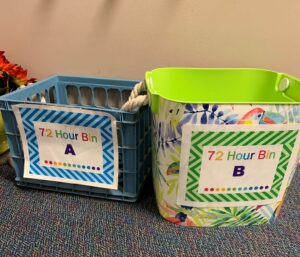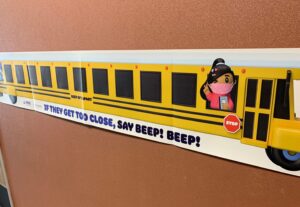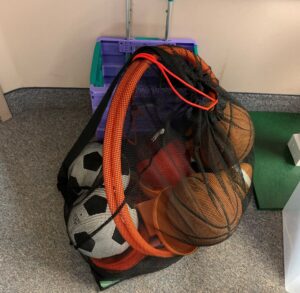“Nothing is going to be perfect, and that’s o.k.” This is how Christine Mooney, the Principal of Redwood Elementary School, opened our discussion in a Zoom event on February 11th about their school’s experiences with transitioning from in-school to distance learning and back again. Several teachers, Lisa Jaraslow, Annie Blanchard, Crystal Pump, Lorelei Dean, and Missy Fitzsimmons, put together some tips and tools they’ve learned along the way and shared them with our attendees.
Redwood Elementary is in Grants Pass, Oregon. They started the school year with k-3 in hybrid and 4-5 in distance learning. At the end of November, they moved to all distance learning, and then on February 1, moved back to a hybrid model with all grades. So their 4-5 students just came back into the building for the first time since last year. For some context, their enrollment is 390 students (about 100 less than a typical year). They have three teachers per grade and around 65 total staff.
Their hybrid model divides each class into two cohorts – A and B. As come to school Mon/Thurs, Bs on Tues/Fri, and everyone is online on Wednesday. They eat breakfast, lunch and go to the playground in their own cohorts.
Their experiences, ideas, tips, and tools:
- Partnering with Families
- Setting up the Classroom
- Supporting students’ social and emotional needs
- Keeping Everyone Safe
- Moving through the School
- Playing Outside
- Collaborating with Colleagues
- Offering Final Encouragement
Partnering with Families
- The day those 4th and 5th graders came back, many said, “This is the best day of my life!” In general, the students and families have been so happy and grateful for in-person school. In general, they want to help and follow the rules, so they have learned the new playground boundaries, they’re much less likely to come to school with a cold, etc.
- They’ve paired down standards and focus on social and emotional needs. There is much less time, and children/families need to feel welcome and supported first. Ask what is the most important thing to learn, and focus on that one thing—more integrated learning.
- Families are overwhelmed, so they’ve been sensitive to what families are going through—staff has communicated with families and let them know that they’re there to support no matter the situation. Families can’t be on campus, so that’s a significant change—requiring many phone calls and other ways to communicate.
- PikMyKid app is used by all – school staff, bus drivers, and families. When a parent arrives for pick-up, the app indicates this to the teacher. The class says “good-bye, my friend” or whatever their class routine is, and that student walks to the pick-up area.
- They made protocol videos for things they were repeatedly explaining. For example, the bathroom routine and how the homework notebooks work. The students like the videos—they’ll tune into a video—and it’s a very helpful tool for new students and families. The teacher can direct the family to the procedural videos on their classroom page. They used Loom—a google chrome extension—to record videos, save the link, send it and embed it into their class page.
- Supplies from home– label every single thing (every crayon, every marker). It seems silly, but it is a game-changer. When something falls on the floor, you can say, “Reid, pick up your crayon,” rather than going through a whole process of sanitizing and assessing who’s it is.
- They sent all workbooks home and made copies of whatever they needed for school. They don’t have parents looking for copies – they can see page numbers on their website and have all the materials they need already at home.
- Keep at-home lessons very simple and consistent to follow from week to week. One day spelling, one day rereading the story, and then one day digging in deeper – keeping the same routine each week. Kids are taught the routine at school. Kids know it, and families know it.
Setting up the Classroom
- Routines are even more important because kids aren’t there five days a week or for the entire day – so they need even more practice. They use consistent routines and schedules, have visual classroom schedules, and individual picture schedules for students who need them. At the same time – schedules and routines are going to change. We’re all figuring it out as we go.
- Just like the beginning of the school year, they took time for teaching routines and procedures. They did a lot of practicing and encouraging, and were surprised how the students jumped right in and learned new routines.
- Classrooms with desks set up in pairs with A/B. (As one day and Bs another) with space between pairs.
- Primary students really need to be in more than one space. They move from tables (6-feet apart) to the carpet in small groups. One Kindergarten teacher has students divided into peanut butter and jelly groups that are labeled at the tables. Then she can call the peanut butters to the carpet, where they sit on designated Velcro spots.
- It’s weird adjusting to multiple classes. Which cohort is this? It’s also strange teaching the same thing for two days—more like a middle school teacher. Teachers are noticing different behaviors and learning needs from day to day and between the two groups. Some students are ready to focus on learning, and others need to talk about what’s going on at home.
- They now have 10-12 kids in a room rather than 30. Even though they have less time, they’re taking advantage of this smaller group with different opportunities to connect.
- They are including the whole class community, by video conferencing with the home group for the first 20 minutes of the day to keep the “whole class feeling.” This time is about connection, belonging, and fun. They recognized that it really is two jobs because they’re setting up learning for at-home and in-school. It has been essential to divide the work. For example, in K for the at-home work, one teacher does reading assignments for the week, another does math, and another prepares writing for the whole grade.
Supporting students’ social and emotional needs
- They use creative greetings – air fist bumps, air hugs. They recognize and acknowledge each other every day.
They made space for the transitions and created safety to express a range of feelings.
- “Tell me three feelings about coming back to school.” Sometimes fear comes out after happy and excited, so this helps with expressing multiple feelings. Conversations include feelings about safety and missing friends in different cohorts, etc.
- They also discussed things they loved about distance learning (can see kids’ mouths again) and in-school learning when they went back and forth – so looking for positives in both. Educators modeled a positive attitude, and kids picked up on that.
- Although excited, stamina was an issue in the transition. Teachers planned lots of brain breaks! There were schedule changes, such as later lunches, that impacted student stamina. Also, students that need tier 2 supports get more breaks and different brain tools for more support.
- Even though time is shorter – more time is set aside for SEL curricula and classroom meetings.
They used SEL lessons, and also a lot of SEL is happening in the teachable moments as things arise. Students are developing empathy and problem solving by navigating real challenges.
Keeping Everyone Safe
- Masks
- “Over the nose, under the chin.” They give reminders when masks fall down.
- They have a designated spot in the room for a mask break, but have found that most students have adapted to the masks.
- Mask beards. When eating, they pinch the mask with two fingers and pull it down to a “mask beard.” Then they pinch and bring back up after eating. This way, they are never taking the mask on and off.
- High-Speed Hand Washing. They learned this through health courses. At several transitional times in the day, they line up in alphabetical order 6 feet apart. The 1st person turns the water on, runs hands through the water, and gets soap—then scrubs while walking to the back of the line. Each person in line runs hands underwater, gets the soap, and goes to the end of the line. The second time through, they rinse and grab a paper towel. They’ve practiced and now know the routine. Lesson plans and posters available here: high-speed-hand-washing
- They quarantine certain materials for 72 hours
 (e.g., when students return books from home). They have bins set up in the classroom w/ 72, 48, and 24 hours designations.
(e.g., when students return books from home). They have bins set up in the classroom w/ 72, 48, and 24 hours designations.
The books come from home and get put it in a bin in the 72-hour spot. Then, each day the bins get moved to 48, then 24, then they can be re-used. - All students have water bottles.
- Fogging happens at the end of the day.
Moving through the School
- To get a sense of the physical distance,

they use arms out with various metaphors: airplane arms, zombie arms, elephant trunks. Kids have learned what the distance looks like. - They have designated hallway directions and assigned bathrooms–a flow in the building. Students have all practiced the direction they walk. This is the way we go to recess, to the restroom.
Playing Outside
- The playground is split into zones, and kids are assigned to zones on a rotation.
- One of the zones is where the play structure is – that’s the best day!
- For assigned blacktop days,

there is a bag of playground equipment from their classroom – balls, jump ropes, etc. - Spray painted circles on the ground that are all spread apart for lining up.
- To help the student visualize how many students can be in each part of the play structure, they painted road runners (their mascot) 6 feet apart. This helps the kids see— “oh, two people can be in this area.”
- Play structures get fogged once a day. Tether balls are cleaned after each recess. Students wash their hands before/after.
Collaborating with Colleagues
- There is time set aside to connect in grade-level teams to plan. Adult connection time is so important.
- There are designated people teachers can always go to troubleshoot questions. School leaders have an attitude of no question is too small, “A touched B’s water bottle – what do I do?”
- Educational assistants are assigned to 2 cohorts rather than supporting many classrooms. They are in charge of lunch for the same cohort they’re pushing in for learning support.
- Contact tracing is made easier with a sign-in sheet outside of each classroom. If an adult that isn’t already part of the classroom visits, they sign in at the door each time.
- Bus drivers are on the PikMyKid app for arrival/departure. Students are distanced on the bus, and the busses are fogged.
- Finding the right mask was essential to increasing stamina for adults. That first week back, they spoke a lot (going through safety protocols) and projecting through the mask, so there was a transition period, and teaching with a mask got easier.
Offering Final Encouragement
- You really have to keep a sense of humor!
- Don’t overthink. Plan, but you are going to make mistakes. You can’t do it all perfectly.
- Bounce things off your team and come to agreements together.
- The kids’ excitement has made it all worth it.
